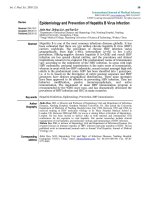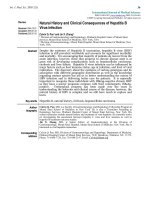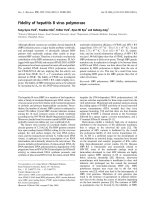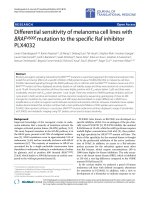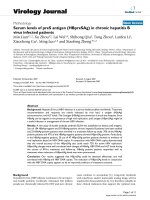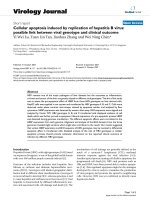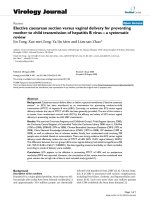Dynamic differences of red cell distribution width levels contribute to the differential diagnosis of hepatitis B virus related chronic liver diseases: A case control study
Bạn đang xem bản rút gọn của tài liệu. Xem và tải ngay bản đầy đủ của tài liệu tại đây (1.06 MB, 9 trang )
Int. J. Med. Sci. 2019, Vol. 16
Ivyspring
International Publisher
720
International Journal of Medical Sciences
2019; 16(5): 720-728. doi: 10.7150/ijms.31826
Research Paper
Dynamic Differences Of Red Cell Distribution Width
Levels Contribute To The Differential Diagnosis Of
Hepatitis B Virus-related Chronic Liver Diseases: A
Case-control Study
Mengjie Zhu, Man Han, Xiaoyu Xiao, Songsong Lu , Zhao Guan, Ying Song, Chen Liu
Department of Clinical Laboratory, Peking University People’s Hospital, Beijing, China
Corresponding author: Chen Liu, PhD. Department of Clinical Laboratory, Peking University People’s Hospital. 11# Xizhimen South Street, Beijing, China.
Phone/Fax: +86 10 88326203. E-mail address:
© Ivyspring International Publisher. This is an open access article distributed under the terms of the Creative Commons Attribution (CC BY-NC) license
( See for full terms and conditions.
Received: 2018.11.27; Accepted: 2019.03.27; Published: 2019.05.10
Abstract
Objective: This study aims to clarify the changes and clinical significance of red cell distribution
width (RDW) during HBV-related chronic diseases, including inactive hepatitis B virus (HBV)
carriers, HBV immune tolerant individuals, chronic hepatitis B (CHB) patients and HBV-related
hepatocirrhosis patients.
Methods: RDW was measured 288 CHB patients, 100 patients with hepatitis B e
antigen(HBeAg)-negative chronic HBV infection (inactive carriers), 92 patients with HBeAg-positive
chronic HBV infection (immune tolerant), and 272 patients with HBV-related hepatocirrhosis. Their
RDW changes were compared with 160 healthy controls. Correlations between RDW and clinical
indicators were conducted. For HBeAg+ CHB patients, RDW was measured before and after
antiviral therapy. The efficiency of RDW to distinguish hepatocirrhosis from CHB and/or inactive
carriers was evaluated by receiver operating characteristic (ROC) curves.
Results: RDW was higher in hepatocirrhosis patients than other groups of patients and healthy
controls. Besides, HBeAg+ CHB patients possessed higher RDW than HBeAg- CHB patients. For
HBeAg+ patients that underwent HBeAg seroconversion after antiviral therapy, RDW was
decreased. RDW was positively correlated with total bilirubin and Child-Pugh scores and negatively
correlated with albumin among hepatocirrhosis patients. The areas under the curve (AUC) of ROC
curves to distinguish hepatocirrhosis from CHB patients was 0.7040 for RDW-standard deviation
(RDW-SD) and 0.6650 for RDW-coefficient of variation (RDW-CV), and AUC to distinguish
hepatocirrhosis from inactive carriers was 0.7805 for RDW-SD and 0.7991 for RDW-CV.
Conclusions: RDW is significantly increased in HBeAg+ CHB patients and patients with
HBV-related hepatocirrhosis and could reflect their severity. RDW could help to distinguish
hepatocirrhosis from CHB patients and inactive HBV carriers.
Key words: hepatocirrhosis; chronic hepatitis B; Red blood cells; Red cell distribution width.
Introduction
Red blood cell distribution width (RDW) is one
hematological indicator which measures size
variability of circulating erythrocytes and reflects the
degree of heterogeneity of erythrocyte volume. RDW
is routinely used in laboratory hematology for
differential diagnosis of anemias [1-2]. Nonetheless,
the assessment of this parameter is broadened far
beyond the differential diagnosis of anemias. RDW
had also emerged as a prognostic marker in a variety
of disorders such as cardiovascular disease, cancer,
Int. J. Med. Sci. 2019, Vol. 16
diabetes, chronic obstructive pulmonary disease,
kidney failure, as well as in other acute or chronic
conditions. The increase of RDW is of high predictive
value for diagnosing a variety of disorders [3-10].
Worldwide, hepatitis B virus (HBV) infection is a
major health problem and chronic infection with
hepatitis B virus (HBV) is estimated to affect 350
million people in the world [11]. In China, where HBV
infection is endemic, there are estimated 93 million
HBV carriers, and among them 30 million are patients
with chronic hepatitis B [12]. Chronic HBV infection is
associated with a wide range of clinical
manifestations, from an asymptomatic carrier status
with normal liver histology to chronic liver diseases
[12-13]. According to EASL 2017 Clinical Practice
Guidelines on the management of hepatitis B virus
infection, the natural history of chronic HBV infection
has been schematically divided into five phases:
HBeAg-positive chronic HBV infection (immune
tolerant), HBeAg-positive chronic hepatitis B,
HBeAg-negative chronic HBV infection (inactive
carrier), HBeAg-negative chronic hepatitis B and
HBsAg-negative phase [14]. In addition, about 15% to
40% of chronically infected people may develop to
chronic and progressive liver diseases, including
cirrhosis and hepatocellular carcinoma (HCC),
whereas the remainders become inactive carriers [15].
The incidence rates of cirrhosis in chronic HBV
infection range from 2% to 7% annually and
meanwhile the cirrhosis incidence rate was 0.7%
among asymptomatic HBV carriers annually [16-18],
so that distinguishing cirrhosis patients from CHB
patients and HBV carriers is quite meaningful.
Concerning about the significance of RDW in
HBV-related diseases, some researches had been
reported [19-24]. RDW values were reported to be
significantly increased in patients with hepatitis B and
were associated with its severity [19-20]. RDW can be
defined as independent predicting factors in hepatic
fibrosis and necroinflammation [21-22]. RDW to
Platelet Ratio (RPR) was reported to be able to predict
fibrosis and cirrhosis in CHB patients [23]. However,
few researches concern about the dynamic differences
of RDW levels during HBV-related chronic liver
diseases and the knowledge of clinical significance of
RDW is also limited. Fan X and his colleagues
reported that RDW among CHB patients was elevated
compared with healthy controls, based on
meta-analysis [24].
This study aims to provide general information
about dynamic differences of RDW levels among
hepatitis B virus-related chronic liver diseases. We
compared the changes of RDW among chronic HBV
infection (inactive carrier and immune tolerant),
chronic hepatitis B, and HBV related hepatocirrhosis
721
patients, we also analyzed whether RDW levels were
different between HBeAg-positive and negative CHB
patients, and before and after anti-virus treatment. We
inquired into the significance of RDW in HBV-related
chronic diseases and gave some insights about its
potential clinical applications.
Materials and Methods
Patients
Chinese subjects with related disease diagnosis
were retrospectively enrolled in this study from our
Hospital from March 2014 to Oct 2017. Based on EASL
2017 Clinical Practice Guidelines on the management
of hepatitis B virus infection, the natural history of
chronic HBV infection has been schematically divided
into five phases: HBeAg-positive chronic HBV
infection (immune tolerant), HBeAg-positive chronic
hepatitis B, HBeAg-negative chronic HBV infection
(inactive carrier), HBeAg-negative chronic hepatitis B
and HBsAg-negative phase [14]. Accordingly, we
included 92 patients with HBeAg-positive chronic
HBV infection (immune tolerant), 100 patients with
HBeAg-negative chronic HBV infection (inactive
carriers), and one case group of 288 chronic hepatitis B
patients(156HBeAg- and 132HBeAg+), all these
patients were recruited according to standards in
EASL 2017 Clinical Practice Guidelines on the
management of hepatitis B virus infection[14].
Another case group included 272 patients with
HBV-related hepatocirrhosis, according to the
following criteria: hepatitis B surface antigen (HBsAg)
carrier for ≥6 months; pathological or clinical evidence
of cirrhosis, including nodularity/splenomegaly on
liver imaging and/or thrombocytopenia. Child-Pugh
score for each hepatocirrhosis patient was calculated
as previously reported [25]. Patients with HCC, a
history of other malignancy, other forms of irrelevant
liver diseases, including hepatitis C virus, serious
alcoholic disease, or autoimmune hepatitis, or
patients who had experienced blood transfusions
within six months were excluded. Among the
HBeAg+ CHB patients, 65 patients who performed
entecavir treatment for more than half a year (6 to 9
months) were analyzed, and changes in RDW before
and after antiviral therapy were compared. The
control group included 160 healthy adults, who had
taken physical examination in the hospital. All
selected individuals were without other irrelevant
chronic diseases and anybody with anemia was also
excluded. All the procedures were carried out in
accordance with Helsinki Declaration, with approval
from institutional ethical review board of Peking
University People’s Hospital.
Int. J. Med. Sci. 2019, Vol. 16
722
Clinical parameter analysis
0.05 are regarded as significant.
Whole blood specimens were obtained by
venipuncture into vacuette tubes containing
K2-EDTA(BD, Franklin Lakes, NJ, USA) and
immediately analyzed to obtain hematological
variables using an automated hematology analyzer
(Sysmex XN-9000; Sysmex, Kobe, Japan). RDW-SD
and RDW-CV were both measured and calculated.
RDW-CV is equal to RDW-SD/MCV. HBsAg and
HBeAg were measured by chemiluminescent
micro-particle immunoassay (CMIA) (Architect i2000
SR, Abbott, IL, USA). Real time PCRs for
quantification of HBV DNA were carried out in the
LightCycler 480 instrument (Roche Applied Sciences).
The levels of aspartate aminotransferase (AST),
alanine aminotransferase (ALT), total bilirubin and
albumin in serum were measured by Beckman
Coulter AU5800 automatic biochemical analyzer
(Beckman
Coulter
Inc.,
Brea,
CA,
USA).
HBsAg<0.05IU/ml,
HBsAb<10S/CO,
HBeAg<1S/CO, HBeAb<1S/CO, HBcAb<1S/CO,
HBV DNA <1000IU/ml, ALT<40U/L, AST<35U/L
were regarded as negative, according to the
manufacturer's instructions.
Results
Statistics
Analyses were carried out with GraphPad Prime
5.5 and SPSS software. ANOVA with the Bonferroni's
Multiple Comparison Test were used to compare
RDW of different groups. RDW levels before and after
therapies were compared by paired student’s t test.
The Pearson correlation coefficient (r) was estimated
between RDW and clinical indicators and Spearman
correlation coefficient (r) was estimated between
RDW and Child-Pugh scores. Receiver operating
characteristics (ROC) curves were used to evaluate the
usefulness of RDW to distinguish hepatocirrhosis
from CHB or inactive carriers and area under curves
(AUC) was calculated and optimal cut-off values were
analyzed according to the maximum value of Youden
index (Youden index=sensibility +specificity -1). All
of the statistical tests were 2-tailed. P values less than
Increased RDW in patients with CHB or
HBV-related hepatocirrhosis
The clinical and demographic characteristics of
individuals involved in this study were summarized
in Table 1. There was no significant difference in the
percentage of gender and age distribution (P >0.05)
among different groups. For hematological indicators,
however, the number of white blood cells and
platelets were significant lower in HBV-related
hepatocirrhosis patients than other groups (p<0.05),
which is in accordance with previous studies [26-28].
The levels of RDW, both coefficient of variation
(CV) and standard deviation (SD), of each group were
analyzed and compared by ANOVA with multiple
comparison and the results are shown in Figure 1. We
found that RDW CV and SD were generally
significantly higher in CHB patients and patients with
HBV-related hepatocirrhosis (P<0.05) than in healthy
controls, inactive HBV carriers and immune tolerant
individuals, with the exception that RDW-SD levels
were not significantly different between CHB patients
and inactive carriers. Patients with HBV-related
hepatocirrhosis had significant higher RDW than
CHB patients. Levels of RDW were not different
among healthy controls, inactive HBV carriers and
immune tolerant individuals.
Higher RDW in HBeAg positive CHB patients
than HBeAg negative CHB patients
We further divided CHB patients into HBeAg+
and HBeAg- subgroups since it represents different
stages of CHB [14, 29]. The demographic and clinical
characters of the subgroups were shown in Table S1.
We compared RDW values to decide whether they
were different (Figure 2). We found that the levels of
RDW were significant higher in HBeAg+ CHB
patients than HBeAg+ CHB patients and healthy
controls, for both RDW-SD and RDW-CV.
Table 1. Demographic and clinical characters of the subjects in the study
N
gender
Age(year)
RBC(×1012/L)
WBC(×109/L)
Lymphocyte (%)
Lymphocyte(×109/L)
Neutrophil (%)
Neutrophil(×109/L)
PLT(×109/L)
Healthy controls
160
79F/81M
44.73±15.45
4.80±0.98
6.57±1.73
34.44±7.39
2.24±0.70
56.37±7.79
3.75±1.28
227.8±50.8
immune tolerant
92
45F/47M
41.23±14.01
5.12±1.51
6.09±2.09
354.94±9.35
2.04±0.74
53.21±10.12
3.37±1.76
219.2±86.9
CHB
288
144F/144M
40.17±11.71
5.04±1.06
5.38±1.72*
34.96±8.38
1.82±0.59*
53.62±9.26
2.95±1.22
196.6±73.6
Inactive carriers
100
49F/51M
40.56±11.62
5.24±0.61
6.22±1.86
36.35±9.40
2.20±0.73
54.27±10.01
3.44±1.42
207.8±66.3
Hepatocirrhosis
272
135F/137M
41.20±10.60
4.48±0.89
4.72±1.95***
32.75±9.54
1.51±0.63***
55.23±10.30
2.67±1.47***
120.4±62.2***
*** p<0.001, *p<0.05, compared with healthy controls
Int. J. Med. Sci. 2019, Vol. 16
723
Figure 1. Levels of RDW in inactive HBV carriers, immune tolerant individuals, chronic hepatitis B patients and HBV related hepatocirrhosis
patients. CV (left) and SD (right) of RDW in asymptomatic HBV carriers (n=100), immune tolerant individuals (n=92), chronic hepatitis B patients (n=288), HBV
related hepatocirrhosis patients (n=272) and healthy controls (n=160) were analyzed and compared with each other. Data points are shown with means±standard
deviations and ANOVA with the Bonferroni's Multiple Comparison Test were used to compare RDW of different groups. ***p<0.001; **p<0.01; *p<0.05.
Figure 2. RDW levels in subgroups of CHB patients according to HBeAg expression. The levels of RDW, both CV (left) and SD (right) in HBeAg- CHB
patients (n=156) and HBeAg+ CHB patients (n=132) were analyzed and compared with each other as well as with healthy controls (n=160). Data points are shown
with means±standard deviations and ANOVA with the Bonferroni's Multiple Comparison Test were used to compare RDW of different groups. ***p<0.001.
Correlations between clinical indicators and
RDW were weak for CHB patients and
inactive HBV carriers.
We next inquired into the relationship between
RDW and clinical indicators to clarify the clinical
significance of RDW. First we analyzed the role of
RDW in CHB patients, asymptomatic HBV carriers
and immune tolerant individuals. Correlations were
conducted between RDW (both CV and SD) and
clinical indicators, including HBsAg, HBeAg, HBeAb,
Int. J. Med. Sci. 2019, Vol. 16
HBV-DNA, ALT and AST, and the results are shown
in Table S2. We found that though some correlations
were with p values less than 0.05, the correlation
coefficients (r) were too low, suggesting that the
correlations were weak. We also further analyzed
correlations in sub-groups of CHB patients according
to HBeAg, but these were also no significant
correlations (data not shown).
RDW was decreased after antiviral therapy for
HBeAg+ CHB patients
Among the 132 HBeAg+ CHB patients, 65
patients were treated with entecavir for more than
half a year, and changes in RDW before and after
antiviral therapy were compared and analyzed.
Among the 65 patients, 47 were diagnosed to become
HBeAg- after treatment and 18 were still HBeAg+. We
separately compared RDW levels before and after
treatment for these two groups, as shown in Figure 3.
For patients that were still HBeAg+ after treatment,
RDW-SD and RDW-CV were not significantly
changed before and after treatment. For patients that
underwent HBeAg seroconversion, RDW-SD and
RDW-CV were both significantly decreased after
724
antiviral therapy. These results suggest that RDW
level changes are associated with the outcome of
disease in patients with CHB after therapy.
RDW was significantly correlated with total
bilirubin, albumin and Child-Pugh scores of
patients of with HBV-related hepatocirrhosis.
We next analyzed the relationship of RDW with
clinical indicators among patients with HBV-related
hepatocirrhosis. Clinical indicators that reflect
severity of hepatocirrhosis were collected and their
correlations with RDW were carried out. We found
that there were significant positive correlations
between RDW-CV and T-BIL, between RDW-SD and
T-BIL. Besides, there were also significant negative
correlations between RDW (both CV and SD) and
albumin (Figure 4). In addition, RDW-SD and CV
were also positively correlated with AST (not shown).
As reported, T-BIL is elevated and albumin is
decreased in serum of hepatocirrhosis patients [30],
and our results suggested that increased RDW in
HBV-related hepatocirrhosis was related to the
severity of the disease.
Figure 3. Comparison of RDW levels of HBeAg+ CHB patients before and after antiviral therapy. 65 HBeAg+ CHB patients who were treated with
entecavir for more than half a year were enrolled and RDW levels before and after treatment were analyzed. Among the 65 patients, 47 were diagnosed to become
HBeAg- after the treatment and 18 were still HBeAg+. We separately compared RDW levels before and after treatment for these two groups for both RDW-CV and
RDW-SD, by paired student’s t test. ***p<0.001; *p<0.05; ns, not significant.
Int. J. Med. Sci. 2019, Vol. 16
725
We next calculated Child-Pugh scores for each
hepatocirrhosis patients and correlation analysis was
conducted between RDW and Child-Pugh scores, as
shown in Figure 4, there were significant positive
correlations between RDW (both CV and SD) and
Child-Pugh scores, which prove that RDW is
associated with the severity of HBV-related
hepatocirrhosis.
RDW is of usefulness to distinguish
HBV-related hepatocirrhosis patients from
CHB patients and inactive HBV carriers.
The diagnosis of hepatocirrhosis among CHB
patients and inactive HBV carriers was mainly
dependent on liver imaging and a series of clinical
tests. Our results suggested that patients with
HBV-related hepatocirrhosis were with significantly
higher RDW than CHB patients and inactive HBV
carriers, suggesting the potential diagnosis value of
RDW to distinguish HBV-related hepatocirrhosis
patients from CHB and HBV carriers. We did
preliminary receiver operating characteristics (ROC)
curve analysis to evaluate the usefulness of RDW and
area under curves (AUC) was calculated. As shown in
Figure 5, we found that The AUC of ROC curves to
distinguish hepatocirrhosis from CHB patients was
0.7040 for RDW-SD and 0.6650 for RDW-CV, and
AUC to distinguish hepatocirrhosis from inactive
HBV carriers was 0.7805 for RDW-SD and 0.7991 for
RDW-CV. If we put inactive carriers and CHB
patients together as the control group for ROC
analysis, the AUC was 0.7237 for RDW-SD and 0.6995
for RDW-CV. The optimal cut-off values for RDW (CV
and SD) in each situation were calculated from ROC
curves by the maximum values of Youden index, as
shown in Table 2. We also regarded immune tolerant
individuals or immune tolerant individuals together
with inactive carriers and CHB patients as the control
group and calculated AUC (Table S3), and the AUC
were 0.8187 and 0.7419 for RDW-SD, 0.7597 and
0.7111 for RDW-CV. These results suggested that
RDW could be used as one potential indicator that
helps to diagnose hepatocirrhosis from other
HBV-related chronic diseases.
Figure 4. Correlation analysis between RDW levels and clinical indicators of HBV-related hepatocirrhosis patients. Total bilirubin (T-BIL) and
albumin levels of each patient with HBV-related hepatocirrhosis were measured and child-Pugh score was calculated. Correlation analysis was conducted between
RDW (both CV and SD) and T-BIL, albumin as well as Child-Pugh score of these hepatocirrhosis patients (n=272). Scatter plots with linear fit are shown and r and
p values are listed. P values less than 0.05 are regarded as significant.
Table 2. Cut-off value analysis for RDW from ROC curves by the maximum value of Youden index
Control group
CHB and inactive carriers
Patient group
cirrhosis
CHB
cirrhosis
inactive carriers
cirrhosis
RDW
SD (fl)
CV (%)
SD (fl)
CV (%)
SD (fl)
CV (%)
Cut-off value
43.75
13.05
43.75
13.05
44.05
13.25
Sensitivity %
70.96
66.91
70.96
66.91
68.38
59.93
Specificity %
63.14
64.69
58.68
59.38
69.71
87.00
Int. J. Med. Sci. 2019, Vol. 16
726
Figure 5. ROC analysis of RDW to distinguish hepatocirrhosis from CHB and inactive HBV carriers. ROC curves were used to evaluate the usefulness
of RDW to distinguish hepatocirrhosis from CHB or/and Hepatitis B carriers. The control group included CHB patients (left), inactive HBV carriers (middle), or both
(right), and the patient group included patients with HBV-related hepatocirrhosis. Area under curves (AUC) of RDW-SD (up) or RDW-CV (bottom) were calculated
and listed.
Discussion
RDW is a routine laboratory parameter of
complete blood count and the cost of measuring RDW
is low enough to be extensively used. For a long time,
RDW is used for differential diagnosis of anemias in
laboratory hematology [1-2]. In recent years, however,
a series of reports had been published which
suggested RDW was a prognostic marker in a variety
of disorders [3-10]. Increased RDW reflects a serious
deregulation of erythrocyte homeostasis including
both impaired erythropoiesis and abnormal red blood
cell survival. The reason of increased RDW may be a
variety of underlying metabolic abnormalities, e.g.,
oxidative
stress,
inflammation,
hypertension,
malnutrition, dyslipidemia, and erythrocyte disorders
[31].
A few literatures had reported the significance of
RDW in HBV-related diseases [18-22]. Until now,
however, few researches had studied the dynamic
changes of RDW during the process of chronic HBV
infection. The clinical significance of RDW in inactive
HBV carriers, chronic hepatitis B patients and HBV
related hepatocirrhosis remains unclear. In this study,
we found that RDW was significantly higher in
HBV-related hepatocirrhosis patients and HBeAg+
CHB patients. Besides, RDW was found to be
significantly correlated with biochemical indicators of
HBV related hepatocirrhosis patients and could reflect
severity of hepatocirrhosis. In addition, RDW could
help to diagnose hepatocirrhosis from CHB and
inactive HBV carriers.
HBeAg-positive CHB represents a status of loss
of
immune
tolerance,
which
lead
to
necroinflammatory liver injury and the disease can
advance to significant fibrosis [32]. For HBeAg
negative CHB, there is HBV infection, but the
histological signs of hepatitis disappear, and serum
HBV DNA levels are persistently low [31]. According
to our results, HBeAg positive CHB patients showed
significantly higher RDW than HBeAg negative CHB
patients. But there were no significant correlations
between RDW and clinical indicators for CHB
patients or inactive HBV carriers. The detailed
mechanism for higher RDW among HBeAg positive
CHB patients should to be considered in depth in
future. In addition, we analyzed part of HBeAg+ CHB
patients enrolled in this study, and after antiviral
therapy, RDW levels were significantly decreased for
patients that underwent HBeAg seroconversion. For
patients that are still HBeAg+ after treatment,
RDW-SD and RDW-CV were not significantly
changed before and after treatment. This part of the
results suggests that RDW is associated with the
outcome of CHB after therapy, which could be of
clinical significance for evaluating prognosis after
CHB treatment.
Whether the change in RDW level is one of the
factors leading to disease or the disease causes the
Int. J. Med. Sci. 2019, Vol. 16
change of RDW is worthy of further research, and
several biological and metabolic abnormalities
associated with hepatitis may also have a considerable
impact on erythropoiesis. Some pro-inflammatory
cytokines were reported to inhibit the synthesis of
erythropoietin, impair iron metabolism, thereby
impairing red blood cell maturation, leading to
immature red blood cells entering the bloodstream,
while chronic HBV infection causes obvious
inflammatory reactions in the body, so patients The
inflammatory response may be responsible for the
significant increase in RDW levels in patients with
CHB or cirrhosis that develop from CHB [33-34].
Whether these pro-inflammatory cytokines produce
RDW-lowering effects in HBV-associated chronic
diseases needs to be validated in future experiments,
such as the possibility of placing normal RBCs in sera
of different severity of cirrhosis or CHB patients by in
vitro experiments. Systematic studies can also be
performed in animal models of HBV infection.
Besides, It is worth noting that portal hypertension in
patients with cirrhosis has been reported to cause an
increase in plasma volume and may eventually lead to
a decrease in RBC survival, which could also be the
cause of increased RDW in HBV-related cirrhosis [35] .
As we have known, chronic HBV infection is
associated with a wide range of clinical
manifestations, from an asymptomatic carrier status
with a normal liver histology to severe and chronic
liver diseases. Considerable proportion of chronically
infected people may develop to cirrhosis, whereas the
remainders become inactive carriers. Besides, 0.7% of
asymptomatic HBV carriers could also develop into
cirrhosis
annually
[12-17].
Distinguishing
HBV-related hepatocirrhosis from CHB and inactive
carriers is of important clinical significance.
According to our results, RDW was significantly
increased in cirrhosis patients than in inactive carriers
and CHB patients, which suggest that the dynamic
differences of RDW levels may help their differential
diagnosis. Our preliminary receiver operating
characteristics (ROC) curve analysis proved that RDW
was one potential indicator that could help to
diagnose hepatocirrhosis from other HBV-related
chronic diseases. In addition, RDW was correlated
with T-BIL albumin and child-Pugh scores, which
suggested that increased RDW was associated with
conditions of hepatocirrhosis patients.
There are limitations in this research and still
much more work needs to be done about the
significance of increased RDW levels in HBV-related
chronic diseases. The sample size needs to be enlarged
in the future and the critical cut-off value of RDW to
distinguish hepatocirrhosis patients from CHB
patients or carriers needs to be determined according
727
to multi-centered research as well. Generally, in this
study, we inquired into the change of RDW levels in
HBV-related chronic diseases and studied the clinical
significance of RDW, which could contribute to a
comprehensive understanding of the clinical
significance of RDW during HBV infection.
Abbreviations
Alb: albumin; ALT: alanine aminotransferase;
AST: aspartate aminotransferase; AUC: area under
curves; CHB: chronic hepatitis B; CMIA:
chemiluminescent micro-particle immunoassay; CV:
coefficient of variation; HBcAb: hepatitis B core
antibody; HBeAb: hepatitis B e antibody; HBeAg:
hepatitis B e antigen; HBsAb: hepatitis B surface
antibody; HBsAg: hepatitis B surface antigen; HBV:
Hepatitis B Virus; HCC: hepatocellular carcinoma;
RPR: RDW to Platelet Ratio; RDW: Red cell
distribution width; ROC: Receiver operating
characteristics; SD: standard deviation; T-BIL: total
bilirubin.
Supplementary Material
Supplementary tables.
/>
Acknowledgment
This work was supported by grants from
Natural Science Foundation of China (81401298,
81871230) , the Beijing Natural Science Foundation
(7163228) and Peking University People’s Hospital
Scientific Research development Funds(RS2018-01).
We thank Department of Hepatology of Peking
University People’s Hospital for the share of medical
records.
Competing Interests
The authors have declared that no competing
interest exists.
References
1.
2.
3.
4.
5.
6.
7.
Aulakh R, Sohi I, Singh T, et al. Red cell distribution width (RDW) in the
diagnosis of iron deficiency with microcytic hypochromic anemia. Indian J
Pediatr. 2009; 76: 265-8.
Aslan D, Gumruk F, Gurgey A, Altay C. Importance of RDW value in
differential diagnosis of hypochrome anemias. Am J Hematol. 2002; 69:31-3.
Arbel Y, Weitzman D, Raz R, et al. Red blood cell distribution width and the
risk of cardiovascular morbidity and all-cause mortality. Thromb
Haemostasis. 2014; 111: 300-7.
Hu L, Li M, Ding Y, et al. Prognostic value of RDW in cancers: a systematic
review and meta-analysis. Oncotarget. 2017; 7: 67020-32.
Yazici P, Demir U, Bozkurt E, Isil GR., Mihmanli M. The role of red cell
distribution width in the prognosis of patients with gastric cancer. Cancer
Biomark. 2017; 18: 19-25.
Koma Y, Onishi A, Matsuoka H, et al. Increased red blood cell distribution
width associates with cancer stage and prognosis in patients with lung cancer.
PloS One. 2013; 8:e80240.
Engstrom G, Smith JG, Persson M, Nilsson PM, Melander O, Hedblad B. Red
cell distribution width, haemoglobin A1c and incidence of diabetes mellitus. J
Intern Med. 2014; 276:174-83.
Int. J. Med. Sci. 2019, Vol. 16
8.
9.
10.
11.
12.
13.
14.
15.
16.
17.
18.
19.
20.
21.
22.
23.
24.
25.
26.
27.
28.
29.
30.
31.
32.
33.
34.
35.
Lippi G, Targher G, Salvagno GL, Guidi GC. Increased red blood cell
distribution width (RDW) is associated with higher glycosylated hemoglobin
(HbA1c) in the elderly. Clin Lab. 2014; 60: 2095-8.
Seyhan E C, Ozgul MA, Tutar N, Omur I M, Uysal A, Altın S. Red blood cell
distribution and survival in patients with chronic obstructive pulmonary
disease. COPD. 2013; 10: 416-24.
Lippi G, Targher G, Montagnana M, Salvagno GL, Zoppini G, Guidi GC.
Relationship between red blood cell distribution width and kidney function
tests in a large cohort of unselected outpatients. Scand J Clin Lab Inv. 2008; 68:
745-8.
Beaven SW. No Nukes: A New Way to Treat Hepatitis B. Sci Trans Med. 2014;
229: ec52.
Lu FM, Zhuang H. Management of hepatitis B in China. Chinese Med J. 2009;
122: 3-4.
Liaw Y F, Chu CM. Hepatitis B virus infection. Lancet. 2009; 373: 582-92.
European Association For The Study Of The Liver. EASL 2017 Clinical Practice
Guidelines on the management of hepatitis B virus infection. J Hepatol.
2017;67:370-98.
Lok AS. Chronic hepatitis B. N Engl J Med. 2002; 346:1682-3.
Hsu YS, Chien RN, Yeh CT, et al. Long-term outcome after spontaneous
HBeAg seroconversion in patients with chronic hepatitis B. Hepatology.
2002;35: 1522-7.
Wu JC, Hwang S J, Lai CR, et al. Factors predictive of liver cirrhosis in patients
with chronic hepatitis B: a multivariate analysis in a longitudinal study. Eur J
Gastroen Hepat. 2000; 12: 687-93.
Yu MW, Hsu FC, Sheen I, et al. Prospective study of hepatocellular carcinoma
and liver cirrhosis in asymptomatic chronic hepatitis B virus carriers. Am J
Epidemiol. 1997; 145: 1039-47.
Lou Y, Wang M, Mao W. Clinical usefulness of measuring red blood cell
distribution width in patients with hepatitis B. PloS One. 2012;7: e37644.
Huang R, Yang C, Wu K, et al. Red cell distribution width as a potential index
to assess the severity of hepatitis B virus-related liver diseases. Hepatol Res.
2014; 44:e464-70.
Xu WS, Qiu XM, Ou QS, et al. Red blood cell distribution width levels
correlate with liver fibrosis and inflammation: a noninvasive serum marker
panel to predict the severity of fibrosis and inflammation in patients with
hepatitis B. Medicine. 2015; 94: e612.
Karagoz E, Ulcay A, Tanoglu A, et al. Clinical usefulness of mean platelet
volume and red blood cell distribution width to platelet ratio for predicting
the severity of hepatic fibrosis in chronic hepatitis B virus patients. Eur J
Gastroen Hepat. 2014; 26: 1320-4.
Chen B, Ye B, Zhang J, Ying L, Chen Y. RDW to platelet ratio: a novel
noninvasive index for predicting hepatic fibrosis and cirrhosis in chronic
hepatitis B. PLos One. 2013; 8: e68780.
Fan X, Deng H, Wang X, et al. Association of red blood cell distribution width
with severity of hepatitis B virus-related liver diseases. Clinica Chimica Acta.
2018; 482:155-60.
Cholongitas E, Papatheodoridis GV, Vangeli M, Terreni N, Patch D,
Burroughs AK. Systematic review: the model for end-stage liver
disease–should it replace Child-Pugh's classification for assessing prognosis in
cirrhosis? Aliment Pharm Ther. 2005; 22:1079-89.
Karasu Z, Tekin F, Ersoz G, et al. Liver fibrosis is associated with decreased
peripheral platelet count in patients with chronic hepatitis B and C. Digest Dis
Sci. 2007;52: 1535-9.
Pradella P, Bonetto S, Turchetto S, et al. Platelet production and destruction in
liver cirrhosis. J Hepatol. 2011; 54: 894-900.
Kuriya SI, Nomura T. A study on the mechanism of anemia and leukopenia in
liver cirrhosis. Jpn J Med. 1988; 27:155-9.
Martinot-Peignoux M, Carvalho-Filho R, Lapalus M, et al. Hepatitis B surface
antigen serum level is associated with fibrosis severity in treatment-naive, e
antigen-positive patients. J Hepatol. 2013; 58: 1089-95.
Ikeda K, Saitoh S, Koida I, et al. A multivariate analysis of risk factors for
hepatocellular carcinogenesis: a prospective observation of 795 patients with
viral and alcoholic cirrhosis. Hepatology. 1993;18: 47-53.
Salvagno GL, Sanchis-Gomar F, Picanza A, Lippi G. Red blood cell
distribution width: a simple parameter with multiple clinical applications. Crit
Rev Cl Lab Sci. 2015; 52: 86-105.
Hadziyannis SJ, Vassilopoulos D. Hepatitis B e antigen-negative chronic
hepatitis B. Hepatology. 2001; 34: 617-24.
Jelkmann W. Proinflammatory cytokines lowering erythropoietin production.
J Interferon Cytokine Res. 1998; 18:555–9.
Weiss G, Goodnough LT. Anemia of chronic disease. N Engl J Med.
2005;352:1011–23.
Kimber C, Deller DJ, Ibbotson RN, Lander H. The mechanism of anaemia in
chronic liver disease. Q J Med 1965;34:33–64.
728
research etc. The current research interests in
Professor Liu's group include: (1) Clinical Significance
of coagulation and hematology indicators in diseases.
(2) Development and clinical significance of
regulatory T cells.
Author Biography
Dr. Chen Liu is an associate professor at Peking
University People’s Hospital, Beijing, China. He has
published 12 publications including Arthritis &
Rheumatology, Journal of immunology, leukemia
